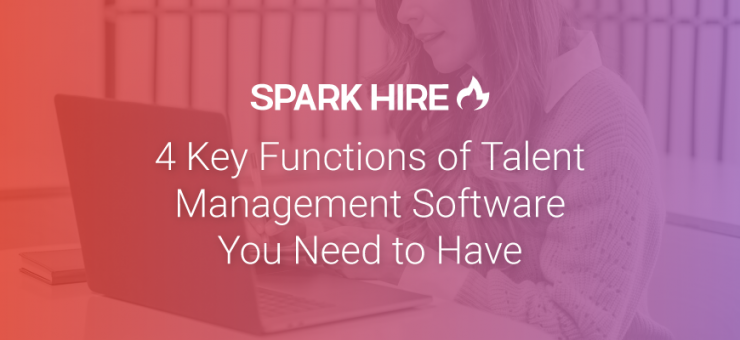With a global pandemic pushing businesses and organizations to go fully remote in the past year, management and human resources (HR) have put a tighter focus on automation and digitizing processes. Specifically, talent management software has proven to be an essential resource.
HR leaders use talent management software to support, automate, and facilitate many of the core areas of management, like compensation, recruitment, and employee development.
However, not all talent management solutions are created equal.
Depending on your organization’s circumstances, you might turn to specific tools to address a single need or invest in a more comprehensive platform. The latter will support a variety of HR needs and allow you to pick the specific features you’d like.
Most organizations will turn to HR consultants to find the best solution. But it’s a good idea to do some research beforehand and get a good grasp on the features you’re looking for. To ensure that your own talent management solution is meeting all of your needs and prepared to support you for the long run, make sure you have these key functions.
4 Key Functions of Talent Management Software
As mentioned, talent management software can support many of your internal HR needs: talent management, compensation, recruitment, and employee engagement. We’ll dive into each one below, as well as discuss the specific software features that can support them.
Talent Management
Talent management involves the majority of your overall leadership tasks. This includes supervising employee work, defining role responsibilities, providing ongoing feedback to team members, and otherwise supporting the overall structure of the company.
When looking for talent management software, make sure you have key features such as:
- Performance review management. Performance review can be a stressful time, for both you and your employees. Streamline this process by taking your performance review online. This way, you have a centralized location to store all of your notes, assign scores to role engagements, and reference job descriptions.
- Job descriptions editor. Having a dedicated place for your organization’s job descriptions makes it easy for both leadership and reports to reference them. Your software should allow authorized staff to make and update job descriptions as needed. You can even create templates to simplify the creation process as your organization grows. Some software even lets you save role-specific documentation and match them with any relevant Federal Fair Labor Standards Act implications.
- Organizational chart creation. Your talent management software should take your job descriptions and provide tools to create organizational charts. This provides a top-down view of all the roles in your organization, including all of the reporting relationships. This is helpful to have in place as your company grows and can aid in figuring out promotion or role expansion opportunities.
- Exit interview questionnaires and analysis. If someone decides to leave your team, having a system for the exit interview is critical. This is one of the best ways to gain feedback and can provide actionable advice given by those who have direct experience with your organization. Create customized interviews, track responses, and even filter interviews by department or manager.
Digitizing your talent management processes is essential during a time when many of your employees are working from home. Without talking to workers in person and seeing them on a day to day basis, it’s difficult to understand if goals are being reached and how they’re faring both personally and professionally.
Compensation
Compensation management is another large component of HR responsibilities at many organizations.
Use software to track your various compensation strategies, from the most simple to more complex approaches such as using incentive pay or hiring gig workers. The last thing you want to mess up or not keep track of carefully is your employees’ compensation, so having a dependable system to store essential data is critical. This way, you can ensure that everyone is being compensated fairly and that your employees are happy within their roles.
In particular, look for system capabilities like:
- Compensation administration. Your team should have a centralized location to estimate and model payroll expenses over the long-term. This is especially invaluable when it’s also integrated with your other talent management features. This way your compensation accounts for overtime, gig workers, and more.
- Job evaluation and pay grading. To ensure that your organization fairly adjusts compensation rates as time goes on and your organization grows, turn to your talent management solution. It should let you create custom job evaluation systems and grade structures based on concrete pay grades.
- Incentive and commission tracking. Depending on the type of compensation strategy you have, look for specific features in your talent management tool that can support them. For incentive or commission pay, ensure your system can determine payouts and commissions as needed based on both organizational and individual employee performance metrics.
- Pay-for-performance tools. Merit-based compensation can be difficult to track. Your solution should help by taking into account your organization’s budgets, performance reviews, and pay grades.
- Total Rewards Statements. Total rewards has become an industry standard for HR teams. Look for tools that pull from your compensation data to generate personalized statements for employees, giving them an overview of their full range of direct and indirect forms of compensation in real time.
COVID-19 has put a strain on the economy, causing many organizations and businesses to rethink their budgets and figure out the best ways to return value to their employees. Having a dedicated solution to help track compensation and ensure it’s being allocated fairly can not only help your organization now, but also well into the future.
Recruitment
A huge difference (besides the move to remote work) between employee management now and pre-COVID-19 is the hiring process.
It’s likely that you already use some sort of standalone recruiting tools and various strategies to create job descriptions and track applications. But using a more comprehensive talent management solution can streamline the process, capture essential recruiting data, and provide you with comprehensive insights on your top candidates.
The essential recruiting-related features to look for include the following:
- Applicant tracking. Look for tools that can collect resumes, analyze responses, and quickly rank your candidates. Then, make sure your software tracks and manages each applicant through the entire hiring process.
- Streamlined onboarding. Once someone is hired, they’ll need to be trained and oriented to your company. To organize this process, especially when working remotely, look for a solution that centralizes the essential steps in a modular system. This way new hires can better access all of their tasks and even sign forms online.
If you’ve been adding members to your team, you’ve likely conducted virtual interviews and training sessions entirely online. This is much different than what you (and new employees) are likely used to, as having a screen isn’t the traditional best way to get to know a candidate or teach new employees the lay of the land. With technology, you can bridge this gap to streamline processes and facilitate meaningful engagements even when you can’t be physically present.
Employee Engagement
Finally, your talent management software should aid your employee engagement efforts.
Employee engagement involves all the aspects of interacting with your team members, like how you communicate with them, the developmental opportunities you offer, and the cultural community your organization provides.
Give your HR team structured support with these key features:
- Staff advancement modules. Employees want to know that your organization is prepared to support them for the long run. Organize and track staff development opportunities within your solution. You can make more effective promotion decisions and track competencies and areas for growth. Your tools should easily identify viable candidates and find those who are ready to advance to a new position.
- Gamification features. Keeping your employees engaged is an ongoing challenge that is exacerbated by remote work. Find tools that provide gamification features to motivate employees with digital points, badges, and trophies for certain goals met and accomplishments.
If you have remote or hybrid employees, setting up the infrastructure to engage employees is critical. This way, your organization has a better chance to thrive and grow well into the future.
Depending on your specific organization’s needs, the type of talent management solution you invest in will differ. Smaller organizations might just need one-off tools, but we do recommend investing in a more comprehensive system sooner rather than later.
This way, you’ll have features that are prepared to help your team grow and you can reap the benefits of an interconnected approach right off the bat. Whichever route you take, ensure that you have the capabilities discussed above. Good luck!
About the Author
 Jennifer C. Loftus is a Founding Partner of and National Director for Astron Solutions, a compensation consulting firm. Jennifer has 23 years of experience at many organizations and volunteers with many notable HR non-profits, including SHRM. There she serves as a subject matter expert to the SHRM Learning System and as a SHRM instructor. In 2014, Jennifer received the Gotham Comedy Foundation’s Lifetime Ambassador of Laughter Award.
Jennifer C. Loftus is a Founding Partner of and National Director for Astron Solutions, a compensation consulting firm. Jennifer has 23 years of experience at many organizations and volunteers with many notable HR non-profits, including SHRM. There she serves as a subject matter expert to the SHRM Learning System and as a SHRM instructor. In 2014, Jennifer received the Gotham Comedy Foundation’s Lifetime Ambassador of Laughter Award.









